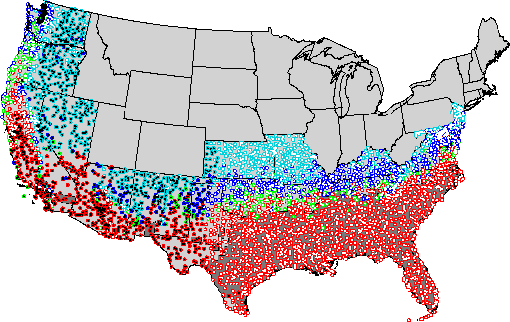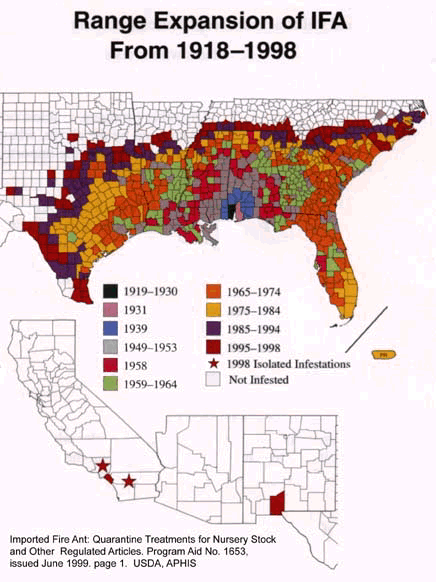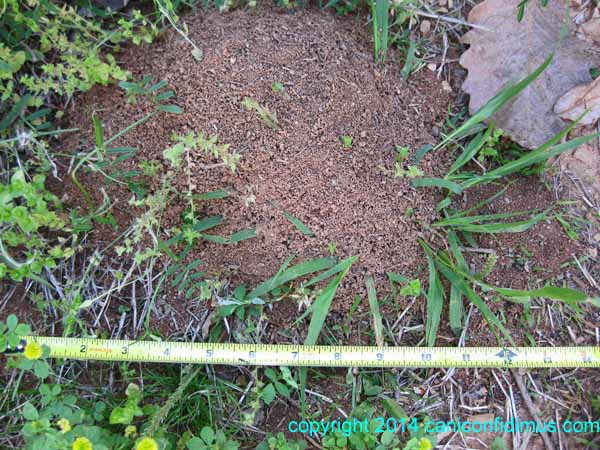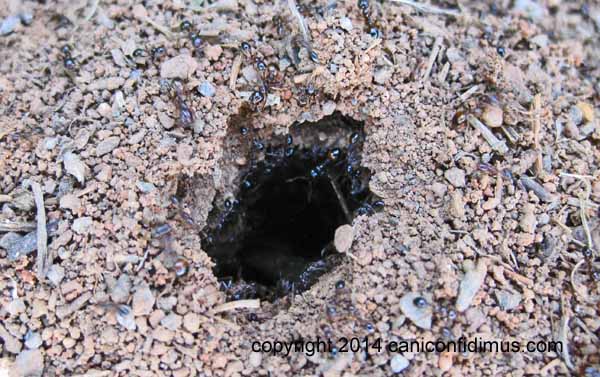The first time I heard about fire ants was about 50 years ago when I was in junior high. It was in Mr. Dorsey’s sixth or seventh grade science class. He was scornful of a state program to eradicate fire ants in south Georgia by aerial spraying of insecticides. He said it would never work; what they needed to do was inject poison into each fire ant nest individually.
That would have been a more ecologically sound approach, since aerial spraying would kill lots of other potentially beneficial bugs and would have killed very few fire ants. Mound-by-mound poisoning might have provided some control in limited locations, but it would have been impossible to find every nest.
For the next couple of decades I didn’t think once about fire ants. And then, one day when I was in graduate school in the early ‘80’s I took at run out into the country behind my parents’ house. For some reason at about the two-mile point I stopped, maybe to take a breather or to let a car pass. I happened to stand in tall grass right on top of a fire ant mound. It was only a matter of seconds before at least one fire ant made it over my shoe and sock to my ankle, where it stung me.
At that point I started noticing fire ant mounds, and once I started noticing them, they seemed to be everywhere. Most sources say they were originally introduced into North America at the port of Mobile around 1940. For a while it seemed like the invasion of fire ants was unstoppable, and they were going to spread and overwhelm everything. The limit to their range seems to be low temperatures and dry conditions.
This is a USDA map that shows the potential range of fire ants. The lightest blue indicates areas where expansion of the range is unlikely. The red is areas with confirmed populations.

This is a USDA map on a University of Texas site showing the history of the fire ants’ expansion:

If I’m reading the map correctly, Floyd County, where we live, is in the 1975-1984 expansion, which is consistent with my impress of when they started showing up around here.
If you don’t have fire ants, you can consider yourself lucky. They are extremely aggressive when defending their nests. If the nest is disturbed, they swarm out in masses and, if you happen to be in the way, they swarm up your feet until they find flesh, and then they latch onto your skin with their pinchers and swing their abdomens around as they sting repeatedly.
I have read at least one Web site that compared the pain intensity of various stings. This site gives a fairly low ranking to the fire ant sting, below a yellowjacket. It’s hard to remember pain levels from 30 years ago, but my impression at the time was not consistent with that. I would have ranked it about the same as a yellowjacket sting, but with longer-lasting effects.
These days my overall impression is that fire ants seem to have reached some kind of equilibrium population. I don’t seem to see as many mounds along the side of the road as I used to. That’s far from a scientific observation, though, and my impression may be wrong. The extension service mentions a pathogen (among other natural enemies) that attacks fire ants. Maybe that has something to do with it.
This is a fire ant nest behind our house. It’s a foot away from an existing nest which I disturbed about a month ago when I borrowed some dirt to use in another place in the yard. You may have trouble reading the tape measure; the mound is about a foot in its widest dimension. It’s a relatively small nest at this point.

The nests are quite deep. It’s easy to drive a stick six inches into such a nest, which I did.

I tried to manipulate the image so the ants are more visible. These ants are darker than the typical red fire ants I most often see around here. I keep my distance when I do something like this. This nest is in line for a dose of fire ant poison, which seems to either kill the nest or drive the ants to some other place.
If you have ants you think might be fire ants, I suggest that you not stick a finger into the mound to test it. Instead, try identifying them by pictures like these.
The title shows the popular scientific name Solenopsis invicta. However, these fire ants were first identified and named wagneri. At this point I’m not sure which name will win.